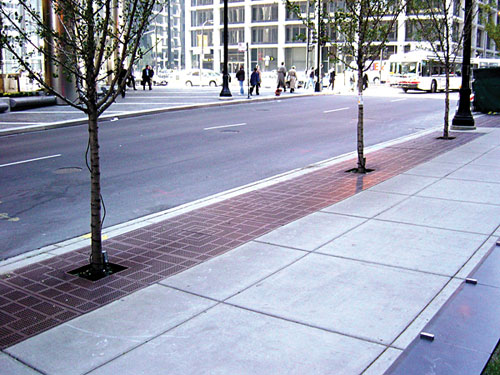Greening the Site: Design Options for Sustainability
The group's tree canopy goals reflect geographic diversity, as well as land use diversity. Their goals recommend an average 40 percent tree canopy cover for urban areas east of the Mississippi and in the Northwest, and 25 percent tree canopy for urban areas in the Southwest and dry West:
For metropolitan areas east of the |
|
Average tree cover counting all zones |
40% |
Suburban residential zones |
50% |
Urban residential zones |
25% |
Central business districts |
15% |
For metropolitan areas in the |
|
Average tree cover counting all zones |
25% |
Suburban residential zones |
35% |
Urban residential zones |
18% |
Central business districts |
9% |
Source: American Forests |
|
In addition to hazards such as construction, auto accidents, and weather-related events, trees in urban areas are most likely to be stressed from poor air quality and soil compaction. This can eventually lead to unstable root systems and stunted growth, with the result being falling or dying trees. Since soil compaction, lack of soil aeration, and poor drainage are common issues to tree mortality, what can be done to enhance root growth and overall tree health? Fortunately, several approaches and techniques exist today that may help your design to sustain and enhance the ability of urban forests and ecosystems to survive and thrive in the harsh, artificial, and confined environments common to our cities.
Grate Systems for Maintaining Urban
Forest Health: Helping Trees to Breathe
Tree grates have long been used as a way to prevent pedestrian traffic from inhibiting the growth of tree roots and affecting the health of trees. Some manufacturers have taken recommendations to improve urban forests as an opportunity to innovate, still providing for people space under a tree canopy, but designing for more air and less compaction of tree roots to aid in the longevity of these trees. "There is increasing awareness of the long term benefits of incorporating trees into the sustainable urban environment. These benefits extend beyond mere aesthetics to social, economic and biologic benefits which provide quantifiable value that increases as the tree thrives. Growing trees in hardscapes has always been a challenge but there are far more options now to support healthy trees while preserving usable, safe, and inviting pedestrian space," says D'Arcy Deeks, Vice President Product and Technology at IRONSMITH.
Developing tree grate systems that suspend the grate over more of the underlying soil can provide more aeration in the soil. This relatively simple approach can let more air get to tree roots, allowing roots to better uptake nutrients and water. Another positive is the benefit of better drainage as less soil area is likely to become compacted. Using large grates or even extensions to the traditional 4-foot by 4-foot tree grate allows additional open soil area, whether parallel to the street or within an urban plaza. This approach has now become a common occurrence and also affects the design, with more and more area devoted to tree grates rather than pavement.
 |
Extended tree grates in downtown Chicago. Photo: Paul Bambauer - IRONSMITH, INC |









